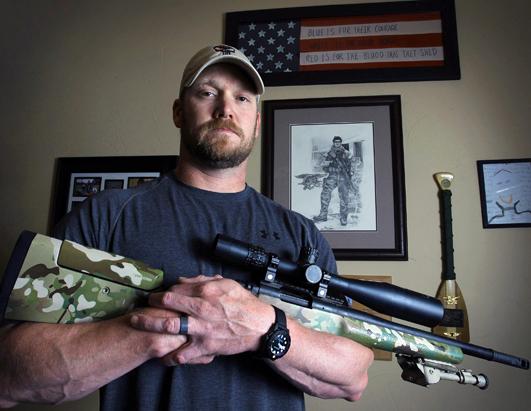After Kyle's death at that shooting range in Texas, most of what has been written about him has been a glowing account of his life as a heroic sniper fighting the bad guys overseas.
I personally did not know much about him, and had no intention of reading his book.
As it turns out, within his book is a look inside the mind of a man who probably should NEVER have been issued the weapon, or given the training, that allowed him to kill 160 people.
Almost exactly one year ago there was an article written and published on a blog called Pro Libertate, and written by a man named William N. Grigg. Mr Grigg DID read Kyle's book and his takeaway was that he was anything but heroic: American Sniper:
The Autobiography of the Most Lethal Sniper in U.S. Military History, the ghost-written memoir for which Kyle claims primary authorship, offers convincing testimony that Kyle not only failed to display genuine courage in Iraq, but was incapable of recognizing it when it was exhibited by desperate patriots seeking to evict the armed foreigners who had invaded and occupied their country.
The insurgents who fought the American invasion (and the few “allied” troops representing governments that had been bribed or brow-beaten into collaborating in that crime) were sub-human “savages” and “cowards,” according to Kyle.
“Savage, despicable evil,” writes Kyle. “That’s what we were fighting in Iraq…. People ask me all the time, `How many people have you killed?’... The number is not important to me. I only wish I had killed more. Not for bragging rights, but because I believe the world is a better place without savages out there taking American lives.”
“The people we were fighting in Iraq, after Saddam’s army fled or was defeated, were fanatics,” Kyle insists. “They hated us because we weren’t Muslim. They wanted to kill us, even though we’d just booted out their dictator, because we practiced a different religion than they did.”
Actually, most of them probably wanted to kill Kyle and his comrades because they had invaded and occupied their country. They were prepared to use lethal force to protect their homes against armed intruders who had no right to be there.
Ironically, Kyle’s book offers evidence that he understands that principle; he simply doesn’t believe that it applies to Iraqis.
“They may have been cowards, but they could certainly kill people,” observes Kyle of the guerrillas.
“The insurgents didn’t worry about ROEs [Rules of Engagement] or court-martials [sic]. If they had the advantage, they would kill any Westerner they could find, whether they were soldiers or not.”
If that charge (made on page 87 of Kyle’s book) is accurate, it might reflect the fact that the Iraqi resistance (as well as the tactics of foreign guerrillas who joined the fight) was playing according to ground rules established by the U.S. early in the war.
On page 79, Kyle describes the Rules of Engagement that his unit followed when they were deployed to Shatt al-Arab, a river on the Iraq-Iran border: “Our ROEs when the war kicked off were pretty simple: If you see anyone from about sixteen to sixty-five and they’re male, shoot ‘em. Kill every male you see. That wasn’t the official language, but that was the idea.” (Emphasis in the original.)
Those orders were of a piece with the studied indifference to civilian casualties that characterized the “Shock and Awe” bombing campaign that began the war. In preparing that onslaught General Tommy Franks and his military planners were guided by a computer program that referred to civilian casualties as “bugsplat.” Franks had no compunction about ordering bombing missions that would result in what the computer projections described as “heavy bugsplat.” After all, aren’t the lives of American military personnel “clearly worth more” – to use Kyle’s phrase -- than those of the Iraqi civilians, who were mere insects to be annihilated?
There is much more, most of it rather stomach churning, but you get the idea.
It can be argued that Chris Kyle was turned into a heartless assassin by a country that needed him to decimate a people who dared to fight back against the Americans who invaded their land, but I am not sure if that is enough to explain the absolute monstrous attitude that he seems to have directed toward these people, that ostensibly. we were there to liberate. And it makes me wonder just how many of those 160 kills were people who presented an actual threat, and how many simply represented a people that he openly despised.
I am certainly not suggesting that Chris Kyle deserved to be gunned down by a PTSD suffering fellow soldier at that shooting range in Texas. I am just saying that after reading this shedding tears of sympathy would seem hypocritical at best.
An article from one year ago offers a troubling look into the murderous mind of the "heroic" American Sniper Chris Kyle.
Info Post

0 comments:
Post a Comment